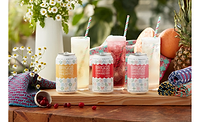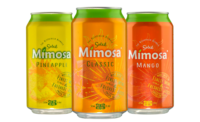Familiarity of citrus drives product differentiation
Ingredients remains top-of-mind in beverage category

Comedian and television host Ellen DeGeneres once said, “When life gives you lemons… they could really be oranges.” Whether it’s lemons, oranges, limes or grapefruits, experts note that the market for citrus beverages is a hot commodity. Used in a combination of flavors and drinks, citrus offers a refreshing, better-for-you enhancement in a wide variety of alcohol and non-alcohol products.
Citrus ingredients are among the most popular raw materials used in the beverage industry, says Ahmed Nour, category development manager for beverages at Symrise NA, Teterboro, N.J. “Whether it’s a mainstream product or a new launch following one of the market trends, you will always find citrus as one of the taste profiles in most brands.”
Experts note the versatility and popularity of using citrus ingredients in beverages. “Citrus flavored still and sparkling waters have seen some significant growth over the past 12-18 months,” says Ton Mesters, vice president of business development at Kerry, Beloit, Wis. “In addition, sports beverages, a variety of teas, low-proof alcoholic beverages, including ‘mocktails’ and spirits, all utilize citrus ingredients alone and in combination with other flavors to deliver differentiated taste experiences.”
Mesters notes that between 2015-2017, citrus food and beverage launches were up 73 percent. “Citrus is associated as being ‘good-for-you’ and can add a ‘refreshing lift’ to the taste profile of a variety of products,” he says. “Orange, lemon and lime-flavored beverages continue to be the preferred choice of flavor.”
Citrus interest
Experts note that health-and-wellness trends are driving consumer interest in citrusy flavors. They perceive citrus flavors as having a “healthy halo” and clearly associated these flavors with attributes like “refreshing” and “fresh,” Mesters says. “In some cases, we are seeing demand for citrus flavor and ingredients with provenance such as Menton lemon. Citrus flavors have proliferated in double-digit growth across several applications in beverages over the past few years.
“Direct-to-retail as well as menu offerings in restaurants have seen many new products and concepts added as consumers seek healthier options at home and on-the-go,” he continues. “Nutritional claims associated with citrus ingredients have more than doubled in the past few years and continue to capture the attention of consumers.”
The familiar taste of citrus ingredients resonate favorably with health-aware and on-the-go consumers. Orange, lemon and lime can be paired by themselves or in combination with other citrus fruits as a way to introduce healthfulness to their beverages, Mesters says.
As American consumers become busier and have less time for traditional meals, they are increasingly turning to functional beverages that can provide vitamins and minerals and on-the-go refreshment. Citrus meets that need state, he adds.
Grapefruit-flavored beverages also are resonating in the market, particularly as consumers thirst for a citrusy and zesty fruity “punch” rather than a traditional sweet taste, Symrise’s Nour says. “Citrus flavors come top of the refreshment pyramid. In addition to most of them promoting a healthy image, they are packed with vitamin C and help decrease the risk of obesity,” he says. “In addition, [citrus fruits] are grown globally in different regions so most consumers have access to one or more of them.
“In non-alcoholic beverages, citrus-infused coffees, especially sparkling coffees, have been trending during the last months, lemon and orange flavored/infused coffees specifically,” he continues. “In other beverage segments like flavored seltzers, hard sodas, shandys and radlers, grapefruit has become a leading flavor profile in new launches.”
Yet, introducing grapefruit-flavored beverages could potentially have some drawbacks. Kerry’s Mesters explains that grapefruit juice consumption may interact with the bioavailability of certain medications, which could then limit the market for it. To combat this challenge, Kerry has developed alternative products that can replace the oils in grapefruits. “Alternatives like these are based on natural citrus oils with other natural flavors and taste exactly like the real thing,” he says.
Maintaining traction
Across all beverage categories, innovation and new product development always will gage consumer interest. “There is continuous activity across the many beverage subsegments, like new and trending cocktail concepts and other flavored low-proof beverages, flavored malts, etc.,” Kerry’s Mesters says.
“The soft drink area is the most active segment right now,” he continues. “Lowering sugar content, cleaning up labels (removing ingredients or replacing with natural alternatives) and changing over to natural citrus flavors or natural citrus extracts is a popular theme.”
Mesters also explains that sparkling waters with only natural citrus flavors or natural citrus extracts, with no added sugar, are posting strong gains. Kerry has positioned themselves in the sparkling water segment with 100 percent natural flavors and extracts that are completely water-soluble and have excellent stability, he says.
Along with sparkling waters, citrus juices have maintained their traction within the subcategory. “In addition to delivering on great taste, citrus juices can be utilized to deliver ‘servings of juice’ and ‘servings of fruit,' in application, as well as a delivery vehicle for materials such as vitamin C, minerals, nutrients, fiber, etc.,” Mesters says. “In some cases, citrus juices may help to provide texture as well as assist in delivering a natural cloud.”
Citrus-flavored teas also are holding their place in the category. “Citrus beverages, especially ready-to-drink teas like Lipton Citrus Iced Green Tea, remain a best-selling item in the industry for some time now,” says John Harper, vice president of marketing and sales, Amelia Bay, Johns Creek, Ga.
Because citrus beverage appeal heavily relies on its natural and better-for-you attributes, recent environmental occurrences have greatly diminished sourcing of some citrus ingredients. Both Symrises’ Nour and Kerry’s Mesters note that huanglongbing (HLB), also known as citrus greening disease, is significantly impacting the citrus crop size and quality in Florida.
“In the short-to-medium term, this will likely lead to high usage of citrus materials from other parts of the world not as severely affected by greening such as Brazil, Mexico and potentially California,” Mesters explains. “The citrus industry in Florida is looking for long-term solutions to battle the effects of greening and it is likely that the industry will make a comeback.”
Citrus ingredients may become scarce in the next few years, which leads to supply and price-related issues, Symrises’ Nour says. To save the citrus wealth, he suggests companies focus on sustainability and other natural processes to bridge the gap brought on by HLB.
Despite sourcing challenges, clean-label citrus flavored beverages will continue to resonate in the marketplace. It acts as a “gateway” for consumers to try new flavors and also may help to revitalize brands and add product-line differentiation and extensions, Kerry’s Mesters says. “Citrus flavors are in high demand and will be an important component in beverage formulations for years to come,” he adds. BI
Looking for a reprint of this article?
From high-res PDFs to custom plaques, order your copy today!






